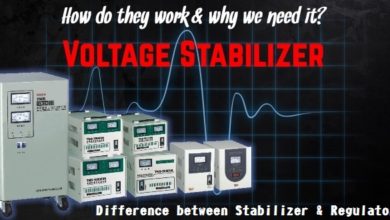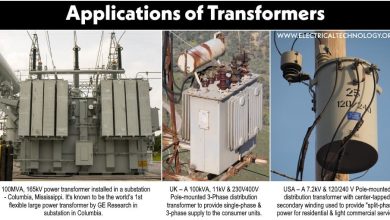Losses in Alternator – Power Stages & Efficiency of Synchronous Generator
Losses in Synchronous Generator – Power Stages & Efficiency of Alternator
An alternator (synchronous generator) and synchronous motor is the same machine except the different power flow stages and as a matter of applications. In short, if the machine converts electrical power into mechanical power, it is known to be a synchronous generator (alternator). If the same machine is used to convert electrical energy into mechanical energy, it is known to be a synchronous motor. The same is the case for losses in synchronous motor and generator as follows.
Related Posts:
- Alternator or Synchronous Generator: Construction, Working, Types & Applications
- EMF Equation of an Alternator and Synchronous Generator
Losses in Alternator
The are different types of losses that occur in an alternator. All these losses can be classified into.
- Electrical Losses
- Magnetic Losses
- Mechanical Losses
Electrical Losses
The electrical losses also known as the copper losses are the most prominent losses in an alternator. It depends on the amount of current passing through a conductor and its resistance. It is usually known as I2R losses. it occurs in both the stator and rotor of the alternator as mentioned below.
Stator Loss: It occurs due to the armature winding resistance and the induced current in the stator. Since the armature current is large, this loss is significant given by
PStator_loss = (IStator)2 (RStator)
Where
- PStator_loss = power loss in stator
- IStator = current induced in stator (armature winding)
- RStator = resistance of stator (armature winding)
Rotor Loss: this loss is relatively very smaller than stator loss due to a small DC rotor current. It is given by
PRotor_loss = (IRotor)2 (RRotor)
Where
- PRotor_loss = Power loss in rotor
- IRotor = Current induced in rotor (field winding)
- RRotor = Resistance of rotor (field winding)
Similarly, the copper I2R losses occur in the other parts of the alternator relatively in a small amount such as
Brushes Loss
PBrush_loss = (IRotor)2 (RBrush)
Diode Rectifier Loss
PDiode_loss = IDiode Vd
Regulator Loss
PRegulator_loss = IRotor Vd
Related Posts:
- Losses in Synchronous Motor – Power Stages & Efficiency of Synchronous Motors
- Losses in a induction Motor – Power Stages in Induction Motors
Magnetic Losses
The magnetic losses are also known as core losses or iron losses. These losses occur in the core of the alternator due to the magnetic property of the material. These losses are classified into two types
- Hysteresis loss
- Eddy current loss
Magnetic Losses = PHys + PEddy
Hysteresis Loss: it occurs due to the magnetization and demagnetization of the ferromagnetic core due to changing magnetic field. A ferromagnetic material does not have the ability to suddenly reverses its magnetization. During a magnetic reversal, it gradually demagnetizes. However, the applied magnetic field changes rapidly. A chunk of applied power is used in the demagnetization of the core. This is known as hysteresis loss given by
PHys = η BMax1.6 fV
Where
- PHys = Hysteresis losses
- η = Hysteresis coefficient
- BMax = Maximum flux density
- f = Supply frequency
- V = Volume of the magnetic material
Eddy Current Loss: Eddy current loss occurs due to the current induced in the core of the alternator. As we know, a varying magnetic field induces a current in a conductor and the core is made of iron which is a good conductor. The induced current is called Eddy current that circulates in the core and opposes the induced voltage thus wasting the power in the form of heat known as Eddy current loss. It is given by
PEddy = ke B2 f2t2V
Where
- PEddy = Eddy current losses
- Ke = Eddy current coefficient
- BMax = Maximum flux density
- f = Supply frequency
- t = Thickness of lamination
- V = Volume of the magnetic material
The Eddy current loss is reduced by laminating the core. The core is designed of thin sheets with lamination between them to reduce the induce (Eddy) current.
Related Posts:
- Losses in a DC Motor – Power Stages & Efficiency of DC Motor
- Losses in a DC Generator – Power Stages & Efficiency of DC Generator
Mechanical Losses
The mechanical losses occur due to the moving parts of the alternator. These are constant losses as the rotor speed is constant in a synchronous generator. There are two types of mechanical losses in an alternator
Friction Losses: In the alternator, friction losses occur in the bearings due to the friction between the rotating part and stationery body. It is given by
PFriction = k N
Where ‘k’ is constant and ‘N’ is the speed in RPM
Windage Losses: the windage losses occur due to the friction between the rotating parts and air. It is given by
PWindage = k N3
Windage losses increase with the cube of speed and also depend on the design of the rotor. A salient pole rotor has higher windage losses due to its protruding poles. Therefore speed is taken into account while designing the rotor.
Stray Losses: stray losses are the miscellaneous small losses that occur in an alternator due to various reasons but they cannot be easily accounted for such as flux distortion, non-uniform current distribution in the armature, etc. It is taken as 1% or 0.01 of the total losses.
Related Posts:
- Losses in Electrical Machines – Formulas and Equations
- Transformer Losses – Different Types of Losses in a Transformer
Efficiency of Alternator
The efficiency of an alternator is the ratio of output electrical power Pout to the input mechanical power Pin. It is given by
Efficiency, η = POut ÷ Pin
Efficiency, η = POut ÷ (POut + PLosses)
% Efficiency, η = POut ÷ (POut + PLosses) x 100%
The alternator efficiency is inversely proportional to the losses. Where the losses depend on the speed as well as the load current. For a specific alternator, its efficiency only depends on the load current as the speed is constant. An alternator can have a maximum efficiency of around 80%.
The following fig shows the power stages in an Alternator (Power flow of a Synchronous Generator).
Related Post:
- What is Motor Efficiency and How to improve it?
- Transformer Efficiency, All day Efficiency & Condition for Maximum Efficiency
Expression for Alternator Efficiency
Here is the expression for efficiency of the 3-phase alternator
Efficiency, η = POut ÷ (Pout + PLosses)
Its output power is given by
POut = 3VIa cosθ
Where
- V = voltage per phase
- Ia = armature current per phase
- Cosθ = power factor
Where the power losses can be classified as variable and constant losses.
PLosses = PVariable + PConstant
The variable losses depend on the load current such as copper losses while the constant losses only depend on speed which is constant in a synchronous generator. Therefore
P Variable = 3Ia2Ra
The field winding losses and the mechanical losses are constant given by.
PConstant = PRotor + PMechanical + PMisc
Pc = If2R + PHys + PEddy + PMisc
Therefore the total power losses become
PLosses = 3Ia2Ra + Pc
Hence the expression for the efficiency of an alternator becomes
η = POut ÷ (POut + PLosses)
η = 3VIacosθ ÷ (3VIacosθ +3Ia2Ra + Pc)
Condition for Maximum Efficiency
The efficiency of an alternator will be maximum when its variable losses become equal to the constant losses.
PVariable = Pc
3Ia2Ra = Pc
Related Posts:
- Single-Phase Induction Motor – Construction, Working, Types & Applications
- Three-Phase Induction Motor – Construction, Working, Types & Applications
- Synchronous, Stepper and AC Motors Formulas and Equations
- Synchronous Motor: Construction, Working, Types & Applications
- EMF Equation of a Transformer
- Power, Voltage and EMF Equation of a DC Motor
- Torque Equation of Induction Motor
- Equivalent Circuit of Induction Motor
- Equivalent Circuit of Electrical Transformer
- Difference between Synchronous and Asynchronous Motor







